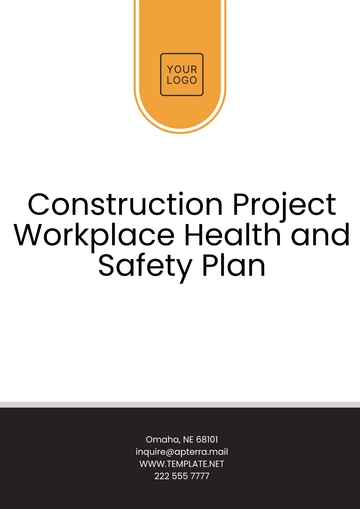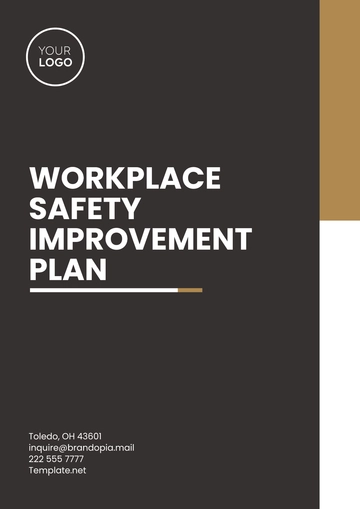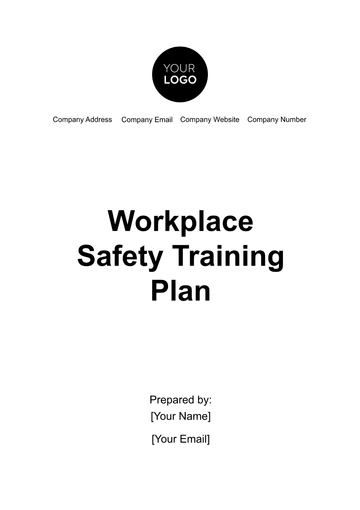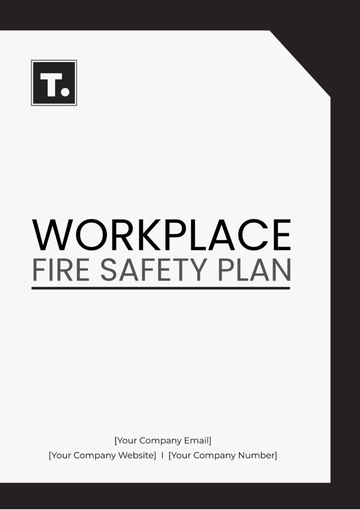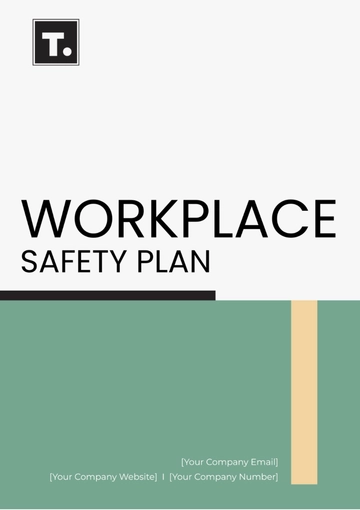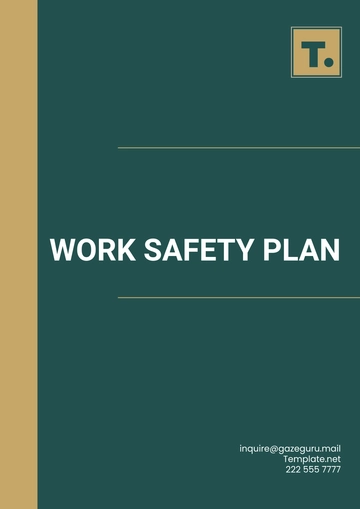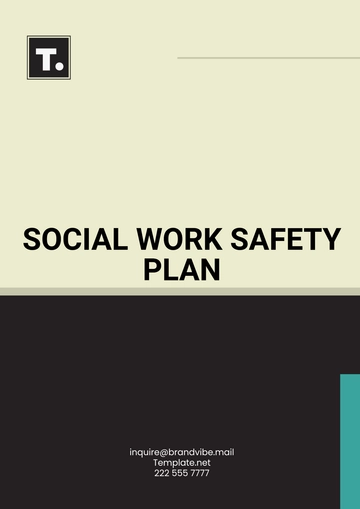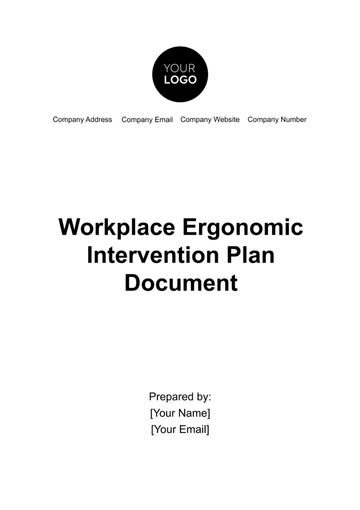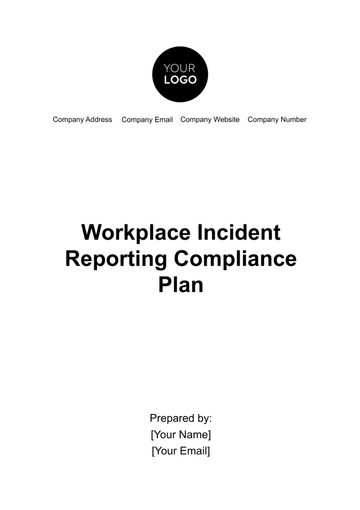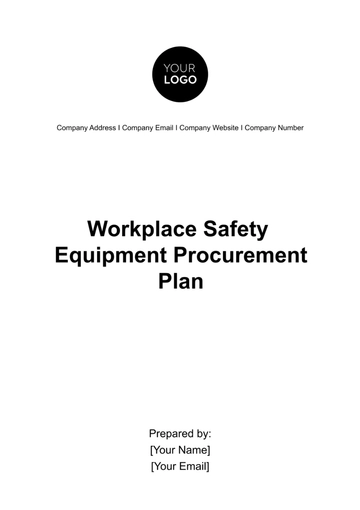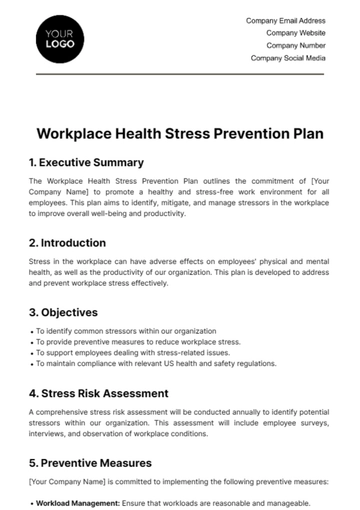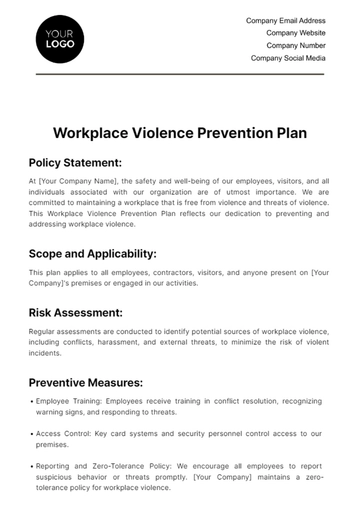Free Social Work Safety Plan
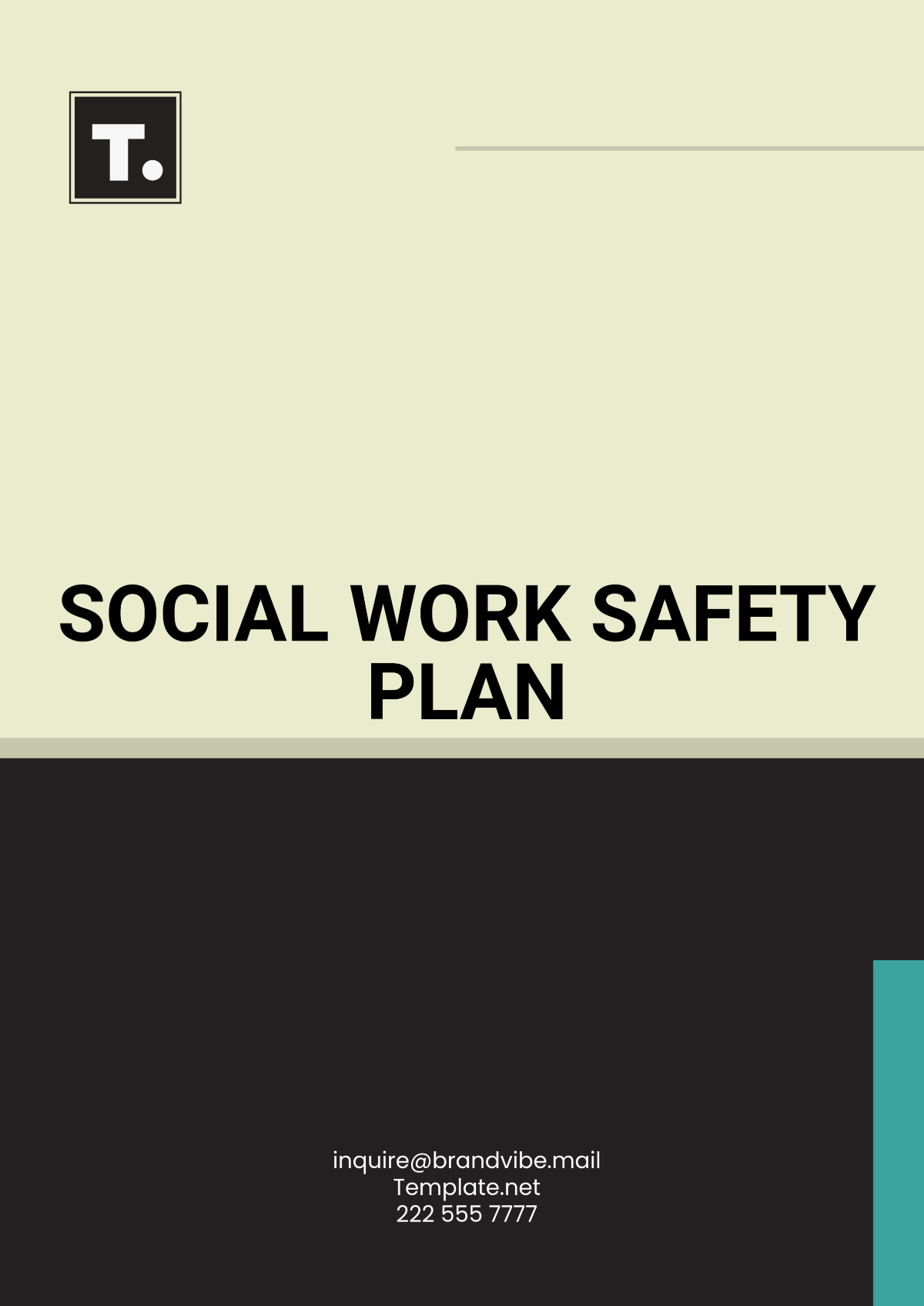
Prepared by: | [YOUR NAME] |
Company: | [YOUR COMPANY NAME] |
Department: | [YOUR DEPARTMENT] |
Date: | [DATE] |
I. Introduction
Purpose: This template provides a structured framework for social workers and professionals to ensure client safety and well-being. It enhances risk assessment, timely safety measures, and access to emergency resources.
Scope: Applicable to various social work domains like child welfare, mental health, elder care, and more. Addresses physical and emotional risks, crisis management, and diverse client needs.
Key Components:
Risk Assessment: Detailed guidelines for identifying risks through interviews, observations, and records.
Safety Interventions: Immediate and long-term strategies like safe housing, therapy, and community support.
Emergency Response: Steps for client and worker safety, contracting services, and documentation.
Resource Networks: Internal (crisis teams, counseling) and external support (shelters, health services) for collaboration.
II. Risk Assessment
A. Identification of Potential Risks
Physical Violence: Assess situations where clients may be at risk of physical harm, such as domestic violence, workplace violence, or community violence.
Emotional Abuse: Look for signs of verbal abuse, psychological manipulation, or coercive control that may harm the client's mental and emotional well-being.
Neglect or Inadequate Care: Evaluate living conditions, caregiver behaviors, and access to essential services to identify instances of neglect or inadequate care.
Self-harm or Suicidal Thoughts: Screen for signs of self-harm behaviors, suicidal ideation, or risk factors related to mental health conditions.
B. Tools and Methods for Risk Evaluation
Client Interviews and Self-Reports: Conduct structured interviews or use assessment tools to gather information directly from clients regarding their safety concerns, experiences of violence or abuse, and mental health status.
Observations by Social Work Professionals: Utilize trained professionals to observe client interactions, living environments, and behaviors for signs of risk or safety issues.
Previous Records and Case Files: Review existing records, history of trauma, past interventions, and documented risk assessments to inform current risk evaluations.
Feedback from Family Members and Caregivers: Engage with family members, caregivers, or other involved parties to gain insights into the client's social support network, family dynamics, and potential risks within the client's environment.
III. Safety Interventions
A. Immediate Safety Measures
Secure Safe Housing When Necessary: Coordinate with relevant agencies or shelters to provide immediate housing solutions for clients facing homelessness, domestic violence, or unsafe living conditions.
Enforce Personal Boundaries: Educate clients on setting and maintaining personal boundaries in relationships, workplaces, or social environments to prevent further harm or exploitation.
Provide Constant Supervision if Required: Arrange for temporary or ongoing supervision by qualified professionals or support personnel to ensure immediate safety in high-risk situations, such as during mental health crises or substance abuse episodes.
B. Long-Term Safety Strategies
Regular Check-Ins with Social Workers: Schedule routine follow-up meetings or check-ins with assigned social workers to monitor progress, assess ongoing safety needs, and adjust interventions as necessary.
Tailored Therapy Sessions: Facilitate access to individual or group therapy sessions tailored to address underlying trauma, mental health concerns, or behavior patterns contributing to safety risks.
Community Support and Involvement: Connect clients with community resources, support groups, peer networks, or advocacy organizations to foster social connections, resilience, and ongoing support beyond immediate crises.
IV. Emergency Procedures
In acute crises, it's crucial to act swiftly and decisively to ensure the safety of everyone involved. Follow these steps:
Ensure the Immediate Safety of the Client and Social Worker:
Assess the immediate danger and prioritize removing the client and social worker from harm's way.
Utilize de-escalation techniques and crisis intervention skills to manage volatile situations and reduce risks.
Contact Emergency Services if Necessary:
Dial emergency services (911 or relevant local emergency numbers) immediately if there is a threat to life, severe injury, or imminent danger.
Provide clear and concise information about the situation, location, and any specific risks or injuries.
Notify Relevant Family or Community Support:
Inform designated emergency contacts, family members, or support networks about the crisis promptly.
Collaborate with these parties to coordinate additional support, resources, or interventions as needed.
Document the Incident Meticulously:
Record detailed observations, events leading up to the crisis, actions taken, and outcomes.
Include relevant information such as client statements, witnesses, medical assessments, and involvement of law enforcement or emergency responders.
Follow organizational protocols for incident reporting, confidentiality, and data documentation while ensuring compliance with legal and ethical standards.
Follow-Up Actions:
Conduct debriefing sessions for the client, social worker, and involved parties to process the crisis, address emotional reactions, and plan ongoing support strategies.
Review and update safety plans, risk assessments, and intervention strategies based on lessons learned from the crisis incident.
Provide ongoing supervision, support, and resources to mitigate future risks and promote recovery and resilience.
V. Resources For Support
A. Internal Support
Crisis Intervention Teams: Equipped professionals for emergency support, specialized interventions, and staff training on crisis response.
Legal Advisory Services: Guidance on legal matters, collaboration for legal procedures, and confidentiality compliance.
Therapeutic Staff and Counselors: Provide therapy, and crisis counseling, and collaborate on personalized treatment plans.
Utilization of Internal Support:
Establish clear protocols for accessing services.
Foster collaboration among teams for holistic support.
Provide ongoing training and resources for staff effectiveness.
B. External Support
Local Shelters and Help Centers: Provide housing, counseling, and support for homelessness, domestic violence, and at-risk youth.
Community Health Services: Offer mental health assessments, substance abuse treatment, and healthcare resources.
Specialized Non-profits and Advocacy Groups: Provide legal advocacy, child abuse support, and mental health awareness.
Utilization of External Support:
Establish partnerships and referral pathways for seamless client access.
Collaborate on case planning, safety assessments, and advocacy for complex needs.
Train staff on external resources, eligibility criteria, and referral processes.
VI. Monitoring and Control
Regular Safety Reviews
Conduct periodic safety plan assessments to match client needs.
Reassess risks based on changes in client situations and feedback.
Documentation and Record-Keeping
Maintain accurate records of incidents, interventions, and compliance.
Ensure data security and privacy in line with regulations.
Training and Capacity Building
Provide ongoing training on safety protocols and legal obligations.
Develop staff skills in conflict resolution and trauma-informed care.
Adaptation and Innovation
Improve safety protocols based on feedback and emerging trends.
Utilize technology for efficient safety assessments and data management.
Collaboration and Communication
Foster collaboration among teams and involve clients in safety planning.
Share insights, coordinate services, and advocate for safety improvements.
- 100% Customizable, free editor
- Access 1 Million+ Templates, photo’s & graphics
- Download or share as a template
- Click and replace photos, graphics, text, backgrounds
- Resize, crop, AI write & more
- Access advanced editor
Emphasize safety with our Social Work Safety Plan Template from Template.net. This editable and customizable template guarantees comprehensive safety strategies tailored to social work environments. Easily fine-tune specific details using our user-friendly Ai Editor Tool, ensuring adherence to best practices and regulations. Prioritize the well-being of your team and clients with a meticulously crafted safety plan
You may also like
- Finance Plan
- Construction Plan
- Sales Plan
- Development Plan
- Career Plan
- Budget Plan
- HR Plan
- Education Plan
- Transition Plan
- Work Plan
- Training Plan
- Communication Plan
- Operation Plan
- Health And Safety Plan
- Strategy Plan
- Professional Development Plan
- Advertising Plan
- Risk Management Plan
- Restaurant Plan
- School Plan
- Nursing Home Patient Care Plan
- Nursing Care Plan
- Plan Event
- Startup Plan
- Social Media Plan
- Staffing Plan
- Annual Plan
- Content Plan
- Payment Plan
- Implementation Plan
- Hotel Plan
- Workout Plan
- Accounting Plan
- Campaign Plan
- Essay Plan
- 30 60 90 Day Plan
- Research Plan
- Recruitment Plan
- 90 Day Plan
- Quarterly Plan
- Emergency Plan
- 5 Year Plan
- Gym Plan
- Personal Plan
- IT and Software Plan
- Treatment Plan
- Real Estate Plan
- Law Firm Plan
- Healthcare Plan
- Improvement Plan
- Media Plan
- 5 Year Business Plan
- Learning Plan
- Marketing Campaign Plan
- Travel Agency Plan
- Cleaning Services Plan
- Interior Design Plan
- Performance Plan
- PR Plan
- Birth Plan
- Life Plan
- SEO Plan
- Disaster Recovery Plan
- Continuity Plan
- Launch Plan
- Legal Plan
- Behavior Plan
- Performance Improvement Plan
- Salon Plan
- Security Plan
- Security Management Plan
- Employee Development Plan
- Quality Plan
- Service Improvement Plan
- Growth Plan
- Incident Response Plan
- Basketball Plan
- Emergency Action Plan
- Product Launch Plan
- Spa Plan
- Employee Training Plan
- Data Analysis Plan
- Employee Action Plan
- Territory Plan
- Audit Plan
- Classroom Plan
- Activity Plan
- Parenting Plan
- Care Plan
- Project Execution Plan
- Exercise Plan
- Internship Plan
- Software Development Plan
- Continuous Improvement Plan
- Leave Plan
- 90 Day Sales Plan
- Advertising Agency Plan
- Employee Transition Plan
- Smart Action Plan
- Workplace Safety Plan
- Behavior Change Plan
- Contingency Plan
- Continuity of Operations Plan
- Health Plan
- Quality Control Plan
- Self Plan
- Sports Development Plan
- Change Management Plan
- Ecommerce Plan
- Personal Financial Plan
- Process Improvement Plan
- 30-60-90 Day Sales Plan
- Crisis Management Plan
- Engagement Plan
- Execution Plan
- Pandemic Plan
- Quality Assurance Plan
- Service Continuity Plan
- Agile Project Plan
- Fundraising Plan
- Job Transition Plan
- Asset Maintenance Plan
- Maintenance Plan
- Software Test Plan
- Staff Training and Development Plan
- 3 Year Plan
- Brand Activation Plan
- Release Plan
- Resource Plan
- Risk Mitigation Plan
- Teacher Plan
- 30 60 90 Day Plan for New Manager
- Food Safety Plan
- Food Truck Plan
- Hiring Plan
- Quality Management Plan
- Wellness Plan
- Behavior Intervention Plan
- Bonus Plan
- Investment Plan
- Maternity Leave Plan
- Pandemic Response Plan
- Succession Planning
- Coaching Plan
- Configuration Management Plan
- Remote Work Plan
- Self Care Plan
- Teaching Plan
- 100-Day Plan
- HACCP Plan
- Student Plan
- Sustainability Plan
- 30 60 90 Day Plan for Interview
- Access Plan
- Site Specific Safety Plan
